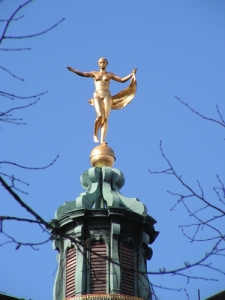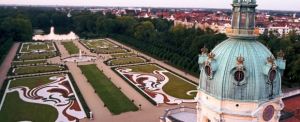A quick update. Things have been pretty quiet as I try to get some writing and editing done. I write this sitting at an outdoor table at a corner cafe on a day that cannot decide between sunshine and haziness, feeling very European.
Last Sunday I did a nice long bike ride through Spandau, a town just west of Berlin, and beyond. I basically just looked on the excellent Berlin atlas my landlady has in the apartment and decided I would ride through Spandau and try to make it to the Berlin Forest to the west of the town. But riding through the very modern town center — with indoor mall, huge streets, etc. — I discovered signs for the old city of Spandau. I was going to ride by but my eye caught a sign for Jüdenstrasse (Jews Street) and had to check it out. (You must know me by now, dear reader.) The few blocks of this old city boasted a collection of very cute medieval-esque buildings, most renovated, some painted wonderfully and many now housing things like Asian restaurants or ice cream or clothing shops or a place selling narguilas. Some of the street signs for Jüdenstrasse explain that the name dates to the 14th century! Amazing. Jews lived here 800 years ago! The Nazis changed the name of the street when they came to power. Here is a photo (not by me) with one of the medieval buildings that caught my eye:
 There is a big citadel in the middle of the Tegelsee (Tegel Lake), alongside which Spandau grew. It is now a museum. I rode over and was going to go in but there was an admission fee and I feel like I don’t want to do any touring without my wife or the kids. One of the items of interest listed on the map at the entrance is “medieval Jewish grave stones” that were at some point discovered in the fortress walls. I kept riding westward, hoping to reach the Berlin Forest some miles off, but the road I was on, getting finally into agricultural country (I could smell manure) and a big old airfield for zeppelins, ended and on another road I tried the bike path came to a stop. Oh well. I turned around. Back at home I looked at my map and now know which way I have to go. Perhaps next time.
There is a big citadel in the middle of the Tegelsee (Tegel Lake), alongside which Spandau grew. It is now a museum. I rode over and was going to go in but there was an admission fee and I feel like I don’t want to do any touring without my wife or the kids. One of the items of interest listed on the map at the entrance is “medieval Jewish grave stones” that were at some point discovered in the fortress walls. I kept riding westward, hoping to reach the Berlin Forest some miles off, but the road I was on, getting finally into agricultural country (I could smell manure) and a big old airfield for zeppelins, ended and on another road I tried the bike path came to a stop. Oh well. I turned around. Back at home I looked at my map and now know which way I have to go. Perhaps next time.
Friday morning I did my more or less weekly laundromat visit. My apartment has no washer or dryer. The place I go to is three blocks away, recommended by my landlady. The owners are an older German couple, very friendly. They spent time living in Chicago and speak some English. This morning the woman greeted me with a big “shalom!” In the past we had broached Jewish topics, but I was little taken aback by this and answered her, I guess self-consciously, with “gut morgen.” But after I finished with my load, between the washing and drying, running some quick errands, I felt remiss so I said “shalom” in leaving. This opened up a flood of conversation. She asked me if I will go to synagogue in the evening. I said yes. She asked which one. I said whatever I said. Then she wanted to know if they serve food and what kind. So I explained a bit about my experiences with kiddushes at shuls erev shabbat, even mentioning the three-course meal they served at the Joachimstaler Strasse shul and my dinners with my Yemenite rabbi friend from the Passauer Strasse shul. All this clearly delighted her. She began talking about their Jewish friends in the neighborhood, one of whom was intermarried, with kids living in Israel, another man whom I should meet who knows all the laws, etc. (It turns out the laundromat couple, both Berliners, are intermarried: he Catholic, she Protestant. Her parents were already similarly intermarried. Her father had been a soldier whom she never knew; she was a “vacation baby,” conceived when he was on vacation from the front — in WW2 obviously — and died in battle.) The husband chimed in now, lamenting the fall away from religion and she agreed. The young generation know nothing, don’t care, don’t know their heritage. Anyway, we closed by agreeing what a mess the world is, with people not learning about each other and fearing-hating that which is unfamiliar.
I guess this is an example of philosemitism. Indeed, it feels both strange yet intriguing to realize one is an exotic object-subject of interest, even attraction. Though I have little evidence on which to go, it seems their curiosity, affection and attraction stems from genuine sentiment, perhaps feelings of guilt (here her father was a soldier in the Nazi war effort, whatever his politics) and even real regret and sadness over the intentional, brutal disappearing (as a transitive verb, as in Latin America) of Berlin multiculturalism.
Today, to sort of continue this train of thought, I met a French sociologist who is a friend or a friend from back home. A child of Russian Jews, her research focuses on Jews in former Communist countries, especially East Germany, the DDR (Deutsche Demokratische Republik). Hence her frequent visits to Berlin. She explained that once Germany split, many of the Jews in the DDR were or became fervent Communists. Her theory is that this enabled them to escape the burden of grappling with the Holocaust and persecution as Jews. As Communists they could participate in, indeed they often led the “new religion” (as she called it) of the DDR, anti-fascism. Indeed, de-nazification proceeded far more successfully and devotedly in the DDR than in West Germany. (Partly this was because blaming everything on the Nazis helped East Germans feel like victims rather than perpetrators and collaborators.) In West Germany, as in the United States, anti-Communism reigned supreme, so that most scholars dismiss these Communist Jews as all being merely self-hating Jews. Their children, on the other hand, born after the war, often became Jewish, even if only cultural Jews, as a form of rebellion. But the crazy, complicated loyalties and identities of Jews in these nations goes so far beyond such simplistic black-or-white ideological categories. A fascinating glimpse, a sobering reminder. Obviously quite secular herself, she asked me if I was religious. I answered and she said she would contact a friend of hers whom I might enjoy meeting, a 90-year old man, the former cantor of the Rykestrasse Synagogue, which had been in the former East Berlin side of the city. Without a rabbi — Judaism, like all religion — was officially condemned, he was the one who held the community together, apparently obtaining personal and spiritual support from his colleagues in the evangelical churches.
I empathize with Alice in her meanderings through Wonderland.


